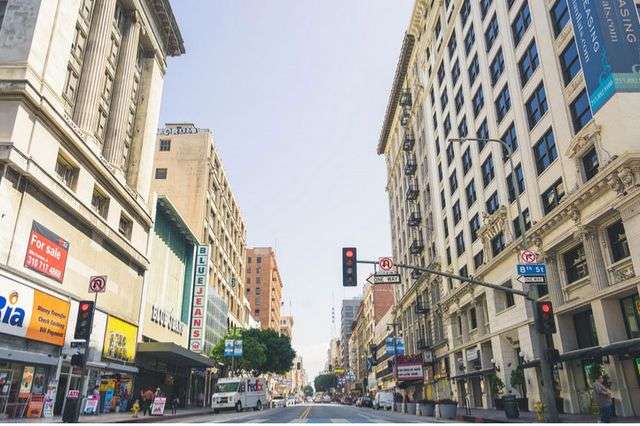L.A.'s buildings loom large in determining street-level air quality

Suzanne Paulson is always looking for ways to help Los Angeles—and the world—breathe a little easier.
L.A. has made progress over the years. The notorious smog that led filmmaker John Waters to remark, "Only in L.A. will you glimpse a green sun or a brown moon," has all but vanished.
Cars are more efficient, and gasoline burns cleaner, thanks to state regulations and research from chemistry experts like Paulson, a UCLA professor of atmospheric and oceanic sciences and a member of the Institute of the Environment and Sustainability. "We changed the gasoline and within a year the air got cleaner," Paulson said. "That's probably the closest thing we've ever had to a silver bullet."
But even with these improvements, L.A. air quality ranks the worst in the nation. The lifestyles of millions of people, sunny weather and basin geography are a perfect storm for pollution to develop and stagnate. And every time scientists address one issue, others emerge.
Paulson, who focuses on the chemical and physical aspects of pressing atmospheric environmental problems, hasn't taken her eye off of the problem, which has serious health impacts for residents. She's now looking at how buildings and streets can be engineered to improve air quality.
One way to do this at street level is by getting vehicular emissions to disperse away from the ground. To tackle that subject, Paulson co-authored a recent study—funded by the California Air Resources Board—that will be published in this month's edition of Science of the Total Environment.
Its main finding? Buildings and open spaces make a big difference in air quality on the ground.
"The built environment has a surprisingly large influence on concentrations of freshly emitted pollutants at the sidewalk level," Paulson said.
To reach that conclusion, researchers drove electric cars equipped with instruments that measure ultrafine particles—pollutants 7,000 times smaller than the width of a human hair. They also looked at video recordings to painstakingly count vehicles to determine traffic flow.
They focused on five different sites in the L.A. area:
- Broadway and 7th Street in downtown L.A., which has rows of tall commercial buildings stacked close together;
- Olive and 12th Street, which features an isolated skyscraper surrounded by open spaces and low buildings;
- Vermont Avenue and 7th Street, which has a skyscraper surrounded by buildings of varying height;
- Wilshire Boulevard and Carondelet Street near MacArthur Park, with a mix of open space and moderately sized buildings; and
- Las Tunas Drive in Temple City, a low, flat residential area with single-family homes and a few small commercial buildings.
From here, the analysis gets a little complicated.
The researchers created a new measurement called "areal aspect ratio." It assigns a numerical value for how big and tall buildings are, how close together they are built, the size of buildings' footprints and the amount of open space in the area. They used that measurement to evaluate each location in the morning and afternoon.
Morning air is typically stagnant. So street-level pollution was higher at that time of day, with no winds to disperse it. The best built environment for cleaner air, the researchers found, had less building mass—in other words, the more open space, the better.
In the afternoon, however, winds above street level become turbulent. That's good for dispersing pollutants—and buildings have a significant effect on how it happens. In particular, isolated tall buildings were effective. "A very tall building can channel that turbulence down and create more mixing," Paulson said.
At all times, researchers found the worst environments were "street canyons," rows of tall buildings without much space between them (The downtown L.A. site is a good example). Street canyons prevent air from mixing and have the highest concentrations of pollutants.
The study recommends that planners consider making room for isolated, tall buildings and buildings of various heights and sizes. Open spaces help too. Especially in the afternoon, these features play a "major role" in dispersing pollutants.
More information: Wonsik Choi et al. The effects of the built environment, traffic patterns, and micrometeorology on street level ultrafine particle concentrations at a block scale: Results from multiple urban sites, Science of The Total Environment (2016). DOI: 10.1016/j.scitotenv.2016.02.083
Journal information: Science of the Total Environment
Provided by University of California, Los Angeles



















